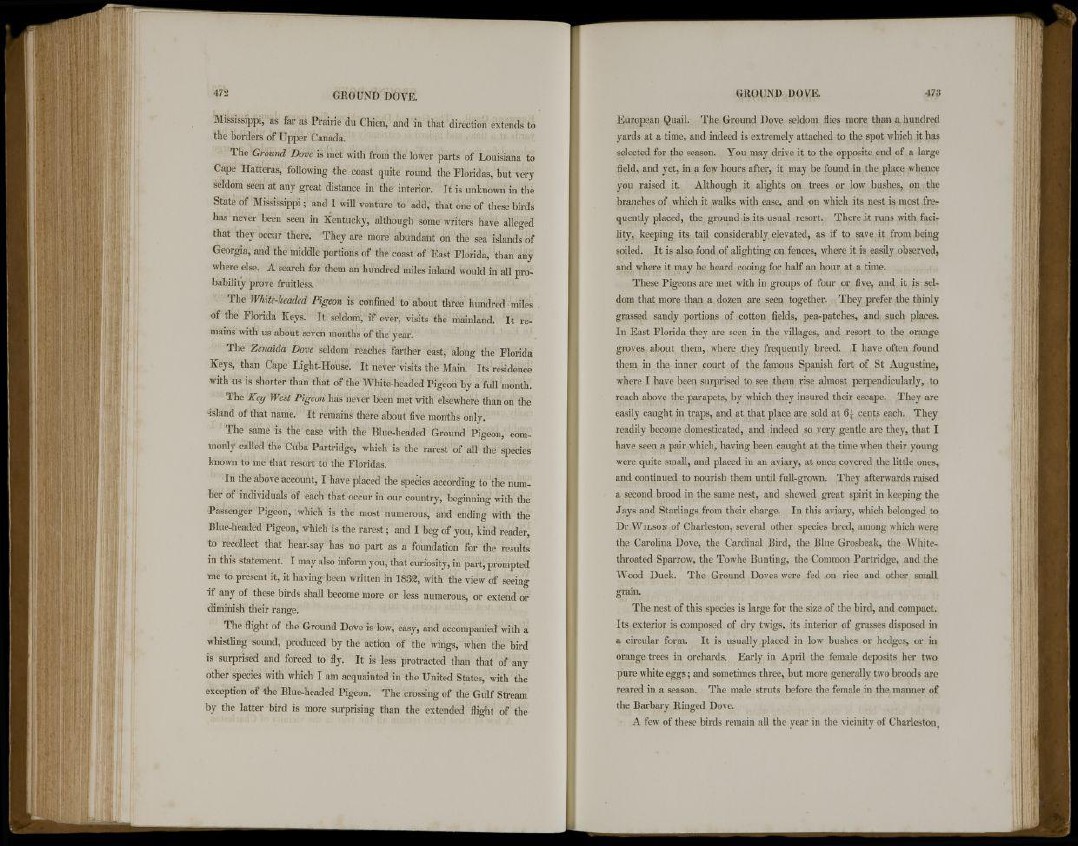
Mississippi, as far as Prairie du Chien, and in that direction extends to
the borders of Upper Canada.
The Ground Dove is met with from the lower parts of Louisiana to
Cape Hatteras, following the coast quite round the Floridas, but very
seldom seen at any great distance in the interior. It is unknown in the
State of Mississippi; and 1 will venture to add, that one of these birds
has never been seen in Kentucky, although some writers have alleged
that they occur there. They are more abundant on the sea islands of
Georgia, and the middle portions of the coast of East Florida, than any
where else. A search for them an hundred miles inland would in all probability
prove fruitless.
The White-headed Pigeon is confined to about three hundred miles
of the Florida Keys. It seldom, if ever, visits the mainland. It remains
with us about seven months of the year.
The Zenaida Dove seldom reaches farther east, along the Florida
Keys, than Cape Light-House. It never visits the Main. Its residence
with -us is shorter than that of the White-headed Pigeon by a full month.
The Key West Pigeon has never been met with elsewhere than on the
island of that name. It remains there about five months only.
The same is the ease with the Blue-headed Ground Pigeon, commonly
called the Cuba Partridge, which is the rarest of all the species
known to me that resort to the Floridas.
In the above account, I have placed the species according to the number
of individuals of each that occur in our country, beginning with the
Passenger Pigeon, which is the most numerous, and ending with the
Blue-headed Pigeon, which is the rarest; and I beg of you, kind reader,
to recollect that hear-say has no part as a foundation for the results
in this statement. I may also inform you, that curiosity, in part, prompted
me to present it, it having been written in 1832, with the view of seeing
if any of these birds shall become more or less numerous, or extend or
diminish their range.
The flight of the Ground Dove is low, easy, and accompanied with a
whistling sound, produced by the action of the wings, when the bird
is surprised and forced to fly. It is less protracted than that of any
other species with which I am acquainted in the United States, with the
exception of the Blue-headed Pigeon. The crossing of the Gulf Stream
by the latter bird is more surprising than the extended flight of the
European Quail. The Ground Dove seldom flies more than a hundred
yards at a time, and indeed is extremely attached to the spot which it has
selected for the season. You may drive it to the opposite end of a large
field, and yet, in a few hours after, it may be found in the place whence
you raised it. Although it alights on trees or low bushes, on the
branches of which it walks with ease, and on which its nest is most frequently
placed, the ground is its usual resort. There.it runs with facility,
keeping its tail considerably elevated, as if to save it from being
soiled. It is also fond of alighting on fences, where it is easily observed,
and where it may be heard cooing for half an hour at a time.
These Pigeons are met with in groups of four or five, and it is seldom
that more than a dozen are seen together. They prefer the thinly
grassed sandy portions of cotton fields, pea-patches, and such places.
In East Florida they are seen in the villages, and resort to the orange
groves about them, where they frequently breed. I have often found
them in the inner court of the famous Spanish fort of St Augustine,
where I have been surprised to see them rise almost perpendicularly, to
reach above the parapets, by which they insured their escape. They are
easily caught in traps, and at that place are sold at Q\ cents each. They
readily become domesticated, and indeed so very gentle are they, that I
have seen a pair which, having been caught at> the time when their young
were quite small, and placed in an aviary, at once covered the little ones,
and continued to nourish them until full-grown. They afterwards raised
a second brood in the same nest, and shewed great spirit in keeping the
Jays and Starlings from their charge. In this aviary, which belonged to
Dr WILSON of Charleston, several other species bred, among which were
the Carolina Dove, the Cardinal Bird, the Blue Grosbeak, the Whitethroated
Sparrow, the Towhe Bunting, the Common Partridge, and the
Wood Duck. The Ground Doves were fed on rice and other small
grain.
The nest of this species is large for the size of the bird, and compact.
Its exterior is composed of dry twigs, its interior of grasses disposed in
a circular form. It is usually placed in low bushes or hedges, or in
orange trees in orchards. Early in April the female deposits her two
pure white eggs; and sometimes three, but more generally two broods are
reared in a season. The male struts before the female in the maimer of
the Barbary Ringed Dove.
A few of these birds remain all the year in the vicinity of Charleston,